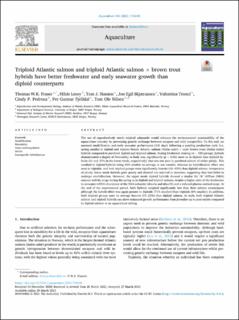| dc.description.abstract | The use of reproductively sterile triploid salmonids would enhance the environmental sustainability of the aquaculture industry by preventing genetic exchange between escapees and wild conspecifics. To this end, we assessed smoltification and early seawater performance (241 days) following a yearling production cycle (i.e. spring smolts) in diploid and triploid female Atlantic salmon (Salmo salar) × male brown trout (Salmo trutta) hybrids compared to purebred diploid and triploid salmon. During freshwater rearing (n = 180/group), hybrids demonstrated a degree of bimodality in body size, significantly (p < 0.05) more so in diploid than triploid hybrids (11 and 37% in the lower mode, respectively) that was not seen in purebred salmon of either ploidy. This resulted in diploid hybrids being 66% smaller on average at sea transfer, whereas no hybridisation effect was seen in triploids, and both triploid groups were significantly heavier (16–43%) than diploid salmon. Irrespective of ploidy, lower mode hybrids grew poorly and showed low survival in seawater, suggesting they had failed to undergo smoltification. However, the upper mode diploid hybrids showed a similar Na+/K+-ATPase (NKA) enzyme activity surge during the spring as in diploid and triploid salmon, despite a higher ratio of the freshwater to seawater mRNA abundance of the NKA subunits (nkaα1a and nkaα1b) and a reduced plasma cortisol surge. At the end of the experimental period, both hybrids weighed significantly less than their salmon counterparts although the hybrid effect was again greater in diploids (71% smaller) than triploids (6% smaller). In addition, both triploid groups were on average heavier (15–22%) than diploid salmon. As such, both triploid Atlantic salmon and triploid hybrids can show enhanced growth performance from juveniles up to post-smolts compared to diploid salmon in an aquaculture setting. | en_US |
